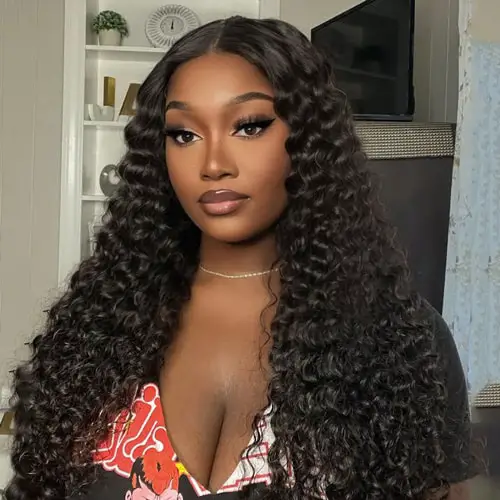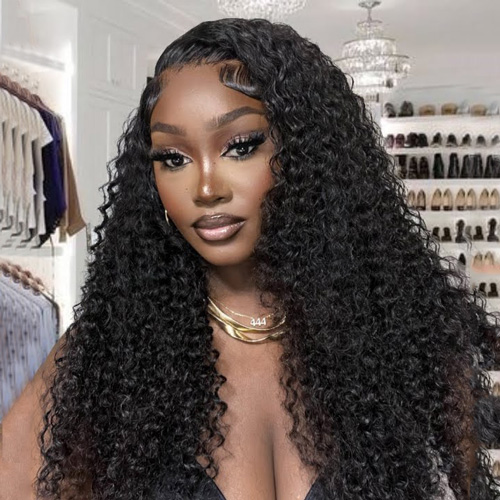Now Is The Time For You To Know The Truth About How Long Do Lace Wigs Last

Lace wigs have become increasingly popular in recent years, offering individuals the opportunity to change their hairstyle or enhance their natural look with ease. However, there is often confusion and misinformation about how long lace wigs can last. In this comprehensive guide, we will explore the factors that determine the lifespan of lace wigs, proper care and maintenance techniques, and tips to maximize their durability. By the end of this article, you’ll have a clear understanding of how long lace wigs can last and how to get the most out of your investment.

Lace wigs.
Before delving into the lifespan of lace wigs, it’s essential to understand what they are and how they differ from other types of wigs. Lace wigs are a type of wig made with a lace base that mimics the appearance of a natural scalp. This lace base is where individual hair strands are hand-tied, giving the wig a more realistic look and feel. Lace wigs come in various types, including full lace wigs, 360 lace wigs and lace front wigs, with the key difference being the amount of lace used in their construction.

Factors affecting the lifespan of lace wigs.
Several factors can impact how long a lace wig lasts. Understanding these factors is crucial for making an informed decision when purchasing and caring for your wig. Here are the key factors to consider:
1. Wig material:
The type and quality of the materials used to make the wig play a significant role in its longevity. High-quality lace wigs made from human hair or premium synthetic fibers tend to last longer than lower-quality alternatives.
2. Wig construction:
The way a lace wig is constructed can affect its durability. Hand-tied wigs generally last longer than machine-made wigs because each hair strand is individually knotted, reducing shedding and ensuring a more natural appearance.
3. Frequency of use:
How often you wear your lace wig can impact its lifespan. Daily wear and constant styling may lead to more wear and tear, shortening the wig’s overall life.
4. Proper care and maintenance:
One of the most critical factors in determining the lifespan of your lace wig is how well you care for it. Regular cleaning, styling, and storage are essential to preserving the wig’s quality.
5. Environmental factors:
Environmental conditions such as exposure to extreme heat, humidity, and UV radiation can affect the integrity of the wig’s materials. Proper storage and protective measures can mitigate these effects.
6. Hairstyling products:
The use of harsh hairstyling products, especially those containing alcohol or sulfates, can damage the wig’s fibers and lead to a shorter lifespan.
7. Hair type:
Human hair lace wigs, whether they are virgin or non-virgin hair, have different lifespans. Virgin human hair typically lasts longer because it hasn’t undergone chemical processing.
Now that we’ve identified the key factors affecting the lifespan of lace wigs, let’s explore each one in more detail to provide you with a comprehensive understanding.

Wig material matters.
The type of material used to make your lace wig is a fundamental factor in determining its longevity. There are two primary types of materials used in lace wigs: human hair and synthetic fibers.
1. Human hair lace wigs:
Lace wigs made from human hair tend to have a longer lifespan compared to synthetic wigs. Human hair is more durable, can withstand heat styling, and is less prone to tangling and frizzing. Additionally, human hair lace wigs offer a more natural look and feel.
2. Synthetic lace wigs:
Synthetic lace wigs are more affordable than their human hair counterparts, but they generally have a shorter lifespan. Synthetic fibers are more prone to heat damage, and their appearance may deteriorate over time. However, high-quality synthetic wigs made from heat-resistant fibers can still last a considerable amount of time if properly cared for.
Different types of human hair have different lasting time.
Different types of human hair used in wigs have varying lifespans due to factors such as hair quality and processing. Let’s delve deeper into the different types of human hair and how they affect the lasting time of wigs:
1. Virgin human hair:
Lifespan:
Virgin human hair wigs typically have the longest lifespan among human hair wigs. They can last for 1 to 2 years or even longer with proper care.
Quality:
Virgin hair is completely unprocessed, meaning it hasn’t been chemically treated, dyed, or permed. This results in hair that is incredibly strong and maintains its natural shine, texture, and strength.
2. Non-virgin human hair:
Lifespan:
Non-virgin human hair wigs have undergone some form of processing, such as coloring, perming, or straightening. While they can still last a considerable amount of time, their lifespan may be shorter than virgin hair wigs, usually ranging from several months to a year.
Quality:
The quality of non-virgin human hair wigs depends on the extent of processing. The more treatments the hair has undergone, the more it may be prone to damage.
3. Remy human hair:
Lifespan:
Remy human hair wigs are known for their high quality and can last for around 6 months to a year or more.
Quality:
Remy hair is collected in a way that preserves the cuticle, which is the protective outer layer of the hair shaft. This results in hair that remains soft, shiny, and tangle-free for a more extended period compared to non-Remy hair.
Frequency of use.
How often you wear your lace wig can significantly impact its lifespan. If you wear your wig daily or for extended periods, it will naturally experience more wear and tear. Here are some tips to help you manage the frequency of use:
Rotation:
If you have multiple lace wigs, rotate them to distribute the wear evenly.
Rest days:
Give your natural hair and scalp a break by going wig-free on occasion.
Protective styles:
Consider wearing a scarf or bonnet at night to protect your wig while sleeping.
Ways to improve your maintenance skills of lasting wigs longer.
Improving your maintenance skills for lace wigs can significantly extend their lifespan, saving you money and ensuring your wigs always look their best. Here are some practical ways to enhance your wig maintenance skills:
1. Invest in high-quality wigs:
Start with a good foundation by investing in high-quality lace wigs. Quality wigs made from superior materials and craftsmanship tend to last longer and require less maintenance.
2. Follow manufacturer’s care instructions:
Always adhere to the care instructions provided by the manufacturer. These guidelines are tailored to the specific wig and materials used, ensuring you don’t inadvertently damage it.
3. Regular cleaning:
Clean your lace wig regularly to remove dirt, oil, and product buildup. Use a wig-specific shampoo and conditioner and follow the recommended washing frequency. Typically, washing every 10-15 wears is a good rule of thumb.
4. Gentle detangling:
Avoid aggressive brushing or combing, as this can lead to hair breakage. Instead, use a wide-tooth comb or a wig brush and start from the ends, working your way up to the roots to gently detangle the hair.
5. Proper storage:
Store your wig on a wig stand or mannequin head when not in use. This helps maintain the wig’s shape and prevents tangling. Avoid leaving it in direct sunlight or extreme temperatures.
6. Avoid overstyling:
While lace wigs offer versatility, excessive heat styling can damage the hair fibers. Use heat styling tools sparingly and always apply a heat protectant before styling.
7. Protective styles:
Consider wearing protective styles under your wig, such as a wig cap or hairnet. These accessories can help protect your natural hair and the wig from friction and oil transfer.
8. Trimming and styling:
Visit a professional wig stylist for regular trims and styling. This ensures that the wig stays in optimal shape and looks its best.
9. Avoid harsh products:
Use wig-friendly products that are gentle on the wig fibers. Avoid using products with alcohol or sulfates, as they can damage the wig.
10. Regular inspections:
Periodically inspect your wig for any signs of damage, such as shedding, thinning, or bald spots. Address any issues promptly to prevent further damage.
11. Know when to replace:
Recognize when it’s time to replace your lace wig. Even with the best maintenance, all wigs have a finite lifespan. Signs that it may be time for a new wig include irreversible damage, excessive thinning, or a worn-out appearance.
Environmental factors.
Environmental conditions can impact the lifespan of your lace wig, particularly when it comes to exposure to heat, humidity, and UV radiation. Here’s how to protect your wig from these factors:
Heat:
Avoid exposing your lace wig to excessive heat from sources like hairdryers, curling irons, and straighteners. If you must use heat styling tools, use them on a low setting and always apply a heat protectant.
Humidity:
High humidity can cause frizz and tangling in synthetic wigs. Consider using anti-frizz products or opting for human hair wigs if you live in a humid climate.
UV radiation:
Prolonged exposure to direct sunlight can fade the color of synthetic wigs and damage human hair wigs. Store your wig in a cool, dark place when not in use.
Hairstyling products.
The use of hairstyling products can affect the longevity of your lace wig. Some products contain harsh chemicals, such as alcohol and sulfates, which can damage wig fibers. Here are some tips to protect your wig from harmful products:
1. Choose wig-friendly products:
Look for styling products specifically designed for wigs, as they are formulated to be gentle on wig fibers.
2. Avoid overloading:
Use hairstyling products sparingly to prevent buildup on the wig. Excessive product use can lead to matting and a dull appearance.
Wig are not one size fits all.
Remember that investing in a high-quality lace wig made from superior materials and craftsmanship can significantly extend its lifespan. Additionally, following a diligent care routine, protecting your wig from environmental factors, and using wig-friendly products will help you enjoy your lace wig for years to come. Now that you have the truth about how long lace wigs can last, you can make informed decisions and get the most out of your investment in this versatile and stylish accessory.
